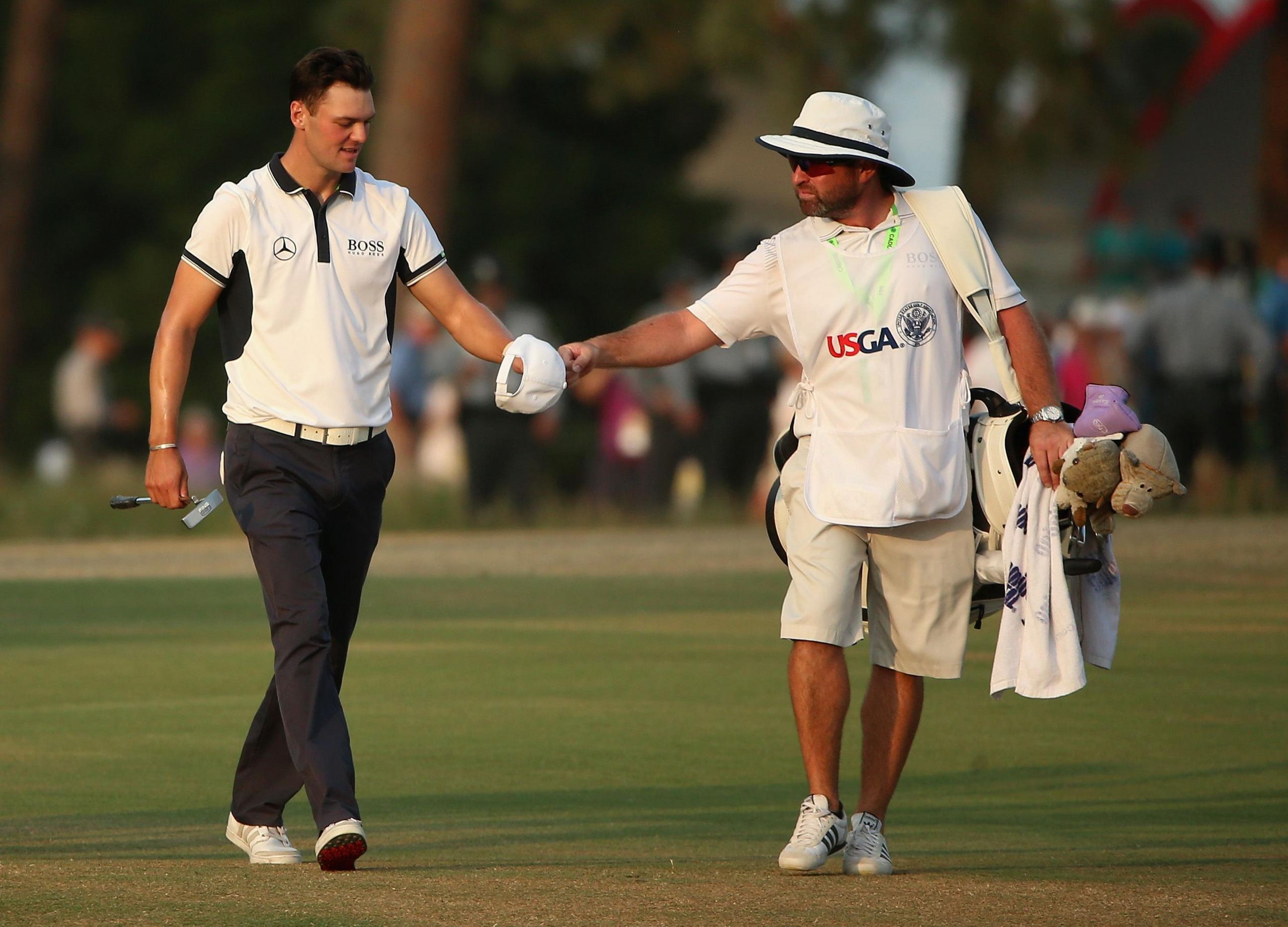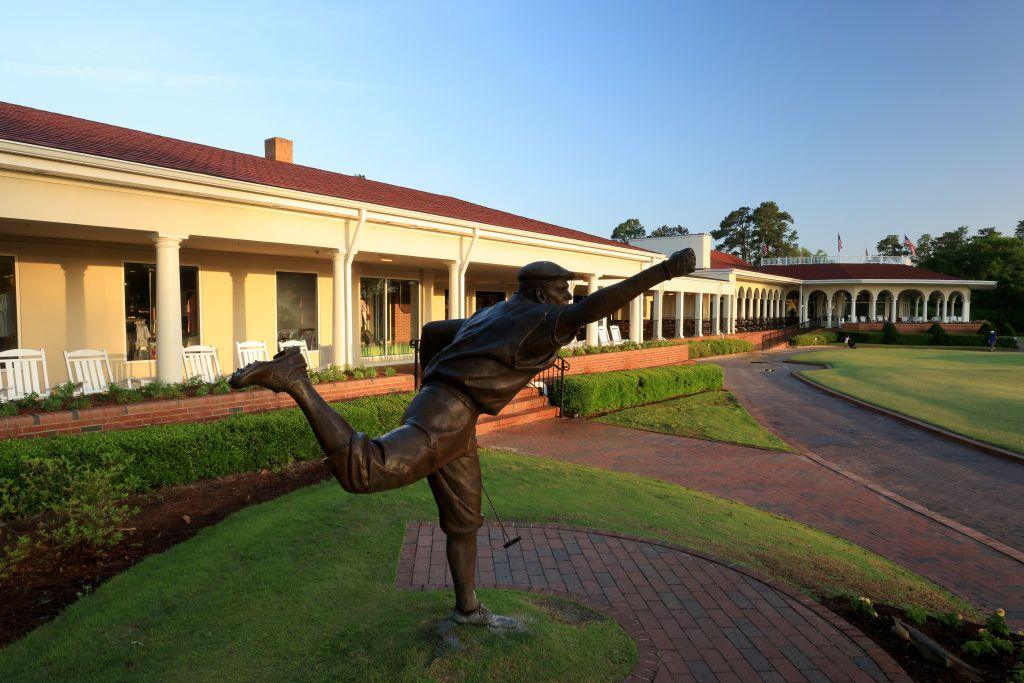'US Open to deliver exacting test of technique and temperament'

Martin Kaymer, with the help of caddie Craig Connelly, won the last US Open staged at Pinehurst in 2014 with an unusually low score
- Published
Level par is invariably the target at the US Open. Competitors capable of matching that are usually firmly in the mix for one golf’s most coveted titles.
There are exceptional years, such as 2023 when Wyndham Clark posted 10 under to win and 17 others beat par. But it was an uncharacteristically forgiving Los Angeles Country Club, where the major record low score of 62 was twice equalled in the first round.
Rory McIlroy (2011), Brooks Koepka (2017) and Gary Woodland (2019) also went low when courses and conditions proved conducive.
But the norm is an exacting test of technique and, perhaps more importantly, temperament. And we can expect this to be the case on the famed Pinehurst Number Two course where Clark defends his title this week.
It may seem odd to make such an assertion because the last time this North Carolina layout hosted the United States' national championship it was properly taken apart by the champion.
Martin Kaymer played a brand of US Open golf that has been rarely matched and won by an extraordinary eight strokes. It was as notable a major performance as any produced by a European golfer.
Scheffler wins Memorial to claim fifth title of 2024
- Published10 June 2024
Strom hits 60 in record-breaking maiden LPGA Tour win
- Published9 June 2024
Grant first woman to win two DP World Tour titles
- Published9 June 2024
The man with the best view of the German’s masterclass in 2014 was his caddie Craig Connelly. “It was Tigeresque,” the Scottish bagman told BBC Sport.
“It was amazing and I think if it was somebody else they might have been talking about it forever.”
Prior to competing like the great Tiger Woods in his pomp, Kaymer had arrived at Pinehurst having dominated the Players Championship with a brilliant wire-to-wire win at Sawgrass a couple of months earlier.
“I remember being surrounded by media after Martin won the Players and saying, perhaps a bit arrogantly, that you guys might have been surprised by this but I had been expecting it,” Connelly said.
“I said, ‘don’t be surprised if he doesn’t win again soon after this’. But little did I think that it would be a mere few weeks later and that it would be the US Open.”
Starting with a pair of stellar 65s, Kaymer was six clear of American Brendan Todd at the halfway stage. The third round was tougher, with a number of left pin placements which hampered his approach play because he likes to fade the ball from left to right.
But Kaymer’s composed 72 limited potential damage and he was still five ahead with one round to go. “He hit that many great golf shots and he was putting really, really well,” Connelly recalled.
Unusually for him, the caddie had scouted pin positions every morning bar the second round when the former world number one had an early tee time. “I think people forget how well he putted,” Connelly added.
The final 69 was a relative cruise. “It was well and truly in the bag for at least four or five holes before the last,” the caddie said.
“But you can never rest on your laurels. He three-putted 16 and he was mad with himself.
“He had come out that morning saying ‘right we’ve got a five shot lead, let’s make it a six shot lead, let’s get to double digits and let’s see how low we can actually go’. So he stayed super aggressive without being silly.”
Connelly added: “At the last he didn’t want to finish with a bogey so right to the end he was setting himself mini goals. When he holed that putt (a 20 footer for par), obviously it was nothing like Payne Stewart’s putt in 1999, but it felt similar.
“Obviously we had the cushion, Payne holed his putt to win by one.”

The late Stewart's winning celebration is one of the iconic images of the sport
The late Stewart’s iconic celebration has gone down in Pinehurst folklore and is commemorated by a statue outside the North Carolina clubhouse. He pipped Phil Mickelson by finishing one under par.
Six years later Michael Campbell held off a charging Tiger Woods to win at level par on the same course and it is worth remembering Kaymer would have won with two under.
But his dominant brilliance on this Donald Ross masterpiece over those four days meant his nine under total was eight strokes better than his closest rivals in a championship where all bar three players were over par.
This is a game where perfect does not exist, but for Connelly this was as close to golfing perfection as he has ever witnessed. “Definitely,” said the seasoned bagman.
“He did hit some shots off line but you’re never going to play four rounds and hit every shot as you’d want to hit it. There will be times when you are tested.”
For that 2014 event the course had been taken back to its original form by designers Ben Crenshaw and Bill Coore. Sandy native areas populated by wire grass plants surround fairways rather than penal rough.
It looked scruffy but made for a proper test with turtle back greens rejecting all but the most accurate approaches and chips. Kaymer also profited from being able to putt from off the green rather than having to chip.
“It's a tree-lined golf course without a tree in play,” four times US Open winner Jack Nicklaus observed last week. “It's the epitome of repelling golf.
“Donald Ross liked repelling golf, that's quite obvious, because everything there, if you miss it, off it goes. I love Pinehurst.”
So what are the key ingredients this week? “Picking your target and hitting the right spots is very, very difficult,” Connelly said.
So look for golfers in command of their iron play. “Absolutely, it’s quite a generous course off the tee but it’s an approach shot golf course,” he added.
“[You have to] have your distance control sorted and [hit the ball] in the right spot on the green because there are only small portions that you can hit to.
“Run offs can be fatal. You can hit a decent shot where on any other course you can easily get it up and down. But at Pinehurst the ball runs off for miles and you are all of a sudden short sided.”
Mental fortitude allied to unerring ball striking are hallmarks of the current world number one Scottie Scheffler. He has the components that fully justify his short odds favouritism and he tuned up in fine fashion with victory in Sunday's Memorial Tournament - his fifth title of the year.
Assuming his journeys to and from the course are not as incident packed as they were at Valhalla for last month’s US PGA Championship, where he was eighth, Scheffler - the Masters champion - is undoubtedly the man to beat.
Like Kaymer a decade ago, he is also the reigning Players champion. Others to consider include Xander Schauffele, the man who broke his major duck at Valhalla, a resurgent Viktor Hovland and Collin Morikawa, who pushed Scheffler so close last week at the notoriously tough Muirfield Village.
“You’ve got to be aggressive to conservative areas and give yourself every opportunity to make the par,” Connelly advised.
“As good as these guys are, I think it will be typical US Open scores where either side of even par could be the number. Unless somebody does a Martin Kaymer then you’ll have a chance at level par.”
Whoever wins, they will have conquered a proper US Open challenge, which should look more photogenic with native pineweed filling in gaps between the penal wire grass bushes which, by design, will be most populous close to expected landing areas.
The bentgrass greens used a decade ago have been replaced by harder wearing 'ultradwarf bermudagrass' that should afford fast and firm surfaces if the weather behaves. The forecast is pretty encouraging on that front with warm and dry conditions expected.
Kaymer is perhaps most famous for his heroics at the 2012 Ryder Cup by holing the putt that meant Europe retained the trophy against all the odds at Medinah.
But it is for how he conquered one of the great tests of American golf that he should most be remembered. He returns this year as a LIV player in the final year of his decade-long US Open exemption that accompanied that epic Pinehurst triumph.
"I always get asked what’s your favourite ever moment,” Connelly mused. “And for a whole host of reasons it remains the best experience I’ve ever had.
“Some might think that Medinah was it, that putt on 18 and what it meant. Absolutely, but it had been a poor week otherwise.
“Whereas that US Open from start to finish was just immense.”
The caddie they call 'The Wee Man' added: “I’m sure all the memories will come flooding back when we reach the property and we’re on that range and on that tee. So I’m really looking forward to it.”
Shouldn’t we all? It feels as though this could be a classic US Open.
Follow live text coverage of all four rounds of the US Open from 1230 BST on Thursday, with radio commentary of the final two rounds on Saturday and Sunday on the BBC Sport website and app and BBC Sounds.